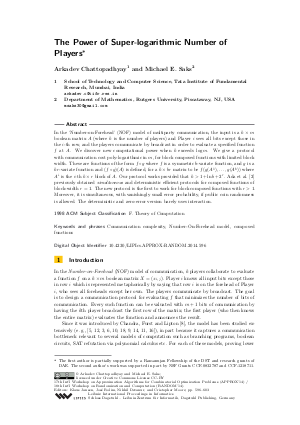The Power of Super-logarithmic Number of Players
Authors Arkadev Chattopadhyay, Michael E. Saks
-
Part of:
Volume:
Approximation, Randomization, and Combinatorial Optimization. Algorithms and Techniques (APPROX/RANDOM 2014)
Part of: Series: Leibniz International Proceedings in Informatics (LIPIcs)
Part of: Conference: International Conference on Randomization and Computation (RANDOM)
Part of: Conference: International Conference on Approximation Algorithms for Combinatorial Optimization Problems (APPROX) - License:
 Creative Commons Attribution 3.0 Unported license
Creative Commons Attribution 3.0 Unported license
- Publication Date: 2014-09-04
File

PDF
LIPIcs.APPROX-RANDOM.2014.596.pdf
- Filesize: 433 kB
- 8 pages
Document Identifiers
Subject Classification
Keywords
- Communication complexity
- Number-On-Forehead model
- composed functions
Metrics
- Access Statistics
-
Total Accesses (updated on a weekly basis)
0Document
0Metadata
Abstract
In the `Number-on-Forehead' (NOF) model of multiparty communication, the input is a k times m boolean matrix A (where k is the number of players) and Player i sees all bits except those in the i-th row, and the players communicate by broadcast in order to evaluate a specified function f at A. We discover new computational power when k exceeds log m. We give a protocol with communication cost poly-logarithmic in m, for block composed functions with limited block width. These are functions of the form f o g where f is a symmetric b-variate function, and g is a (kr)-variate function and (f o g)(A) is defined, for a k times (br) matrix to be f(g(A-1),...,g(A-b)) where A-i is the i-th (k times r) block of A. Our protocol works provided that k > 1+ ln b + (2 to the power of r). Ada et al. (ICALP'2012) previously obtained simultaneous and deterministic efficient protocols for composed functions of block-width one. The new protocol is the first to work for block composed functions with block-width greather than one. Moreover, it is simultaneous, with vanishingly small error probability, if public coin randomness is allowed. The deterministic and zero-error version barely uses interaction.
Cite As Get BibTex
Arkadev Chattopadhyay and Michael E. Saks. The Power of Super-logarithmic Number of Players. In Approximation, Randomization, and Combinatorial Optimization. Algorithms and Techniques (APPROX/RANDOM 2014). Leibniz International Proceedings in Informatics (LIPIcs), Volume 28, pp. 596-603, Schloss Dagstuhl – Leibniz-Zentrum für Informatik (2014)
https://doi.org/10.4230/LIPIcs.APPROX-RANDOM.2014.596
BibTex
@InProceedings{chattopadhyay_et_al:LIPIcs.APPROX-RANDOM.2014.596,
author = {Chattopadhyay, Arkadev and Saks, Michael E.},
title = {{The Power of Super-logarithmic Number of Players}},
booktitle = {Approximation, Randomization, and Combinatorial Optimization. Algorithms and Techniques (APPROX/RANDOM 2014)},
pages = {596--603},
series = {Leibniz International Proceedings in Informatics (LIPIcs)},
ISBN = {978-3-939897-74-3},
ISSN = {1868-8969},
year = {2014},
volume = {28},
editor = {Jansen, Klaus and Rolim, Jos\'{e} and Devanur, Nikhil R. and Moore, Cristopher},
publisher = {Schloss Dagstuhl -- Leibniz-Zentrum f{\"u}r Informatik},
address = {Dagstuhl, Germany},
URL = {https://drops.dagstuhl.de/entities/document/10.4230/LIPIcs.APPROX-RANDOM.2014.596},
URN = {urn:nbn:de:0030-drops-47243},
doi = {10.4230/LIPIcs.APPROX-RANDOM.2014.596},
annote = {Keywords: Communication complexity, Number-On-Forehead model, composed functions}
}
Author Details
References
-
A. Ada. Communication complexity. PhD thesis, McGill University, 2013.

-
A. Ada, A. Chattopadhyay, O. Fawzi, and P. Nguyen. The NOF multiparty communication complexity of composed functions. In International Colloquium on Automata, Languages and Programming (ICALP), pages 13-24, 2012.

-
L. Babai, A. Gál, P. G. Kimmel, and S. V. Lokam. Communication complexity of simultaneous messages. SIAM J. of Computing, 33:137-166, 2003.

-
L. Babai, P. G. Kimmel, and S. V. Lokam. Simultaneous messages vs. communication. In 12th Annual Symposium on Theoretical Aspects of Computer Science (STACS), pages 361-372. Springer, 1995.

-
L. Babai, N. Nisan, and M. Szegedy. Multiparty protocols, pseudorandom generators for logspace, and time-space trade-offs. Journal of Computer and System Sciences, 45(2):204-232, 1992.

-
P. Beame, T. Pitassi, N. Segerlind, and A. Wigderson. A strong direct product theorem for corruption and the multiparty communication complexity of disjointness. Computational Complexity, 15(4):391-432, 2006.

-
Richard Beigel and Jun Tarui. On ACC. Computational Complexity, 4:350-366, 1994.

-
A. K. Chandra, M. L. Furst, and R. J. Lipton. Multiparty protocols. In 15th ACM Symposium on Theory of Computing (STOC), pages 94-99, 1983.

-
A. Chattopadhyay and A. Ada. Multiparty communication complexity of disjointness. Technical Report TR08-002, Electronic Colloquium on Computational Complexity (ECCC), 2008.

-
A. Chattopadhyay, A. Krebs, M. Koucký, M. Szegedy, P. Tesson, and D. Thérien. Languages with bounded multiparty communication complexity. In Symposium on Theoretical Aspects of Computer Science (STACS), pages 500-511, 2007.

-
M. David, T. Pitassi, and E. Viola. Improved separations between nondeterministic and randomized multiparty communication. ACM Transactions on Computation Theory (TOCT), 1(2), 2009.

-
V. Grolmusz. The BNS lower bound for multi-party protocols is nearly optimal. Information and Computation, 112:51-54, 1994.

-
Johan Håstad and Mikael Goldmann. On the power of small-depth threshold circuits. Computational Complexity, 1:113-129, 1991.

-
T. Lee and A. Shraibman. Disjointness is hard in the multiparty number-on-the-forehead model. Computational Complexity, 18(2):309-336, 2009.

-
A. A. Razborov. Lower bounds on the size of bounded-depth networks over a complete basis with logical addition. Math. Notes of the Acad. of Sci. of USSR, 41(3):333-338, 1987.

-
A. A. Sherstov. The multiparty communication complexity of set disjointness. In 44th Symposium on Theory of Computing (STOC), 2012.

-
Roman Smolensky. Algebraic methods in the theory of lower bounds for boolean circuit complexity. In 19th Annual ACM Symposium on Theory of Computing, pages 77-82. ACM Press, 1987.

-
E. Viola and A. Wigderson. Norms, XOR lemmas, and lower bounds for polynomials and protocols. Theory of Computing, 4(1):137-168, 2008.

-
Ryan Williams. Non-uniform ACC circuit lower bounds. In IEEE Conference on Computational Complexity, pages 115-125, 2011.

